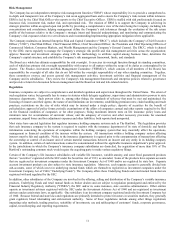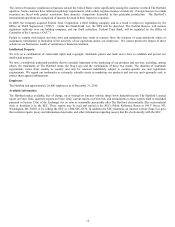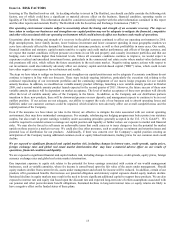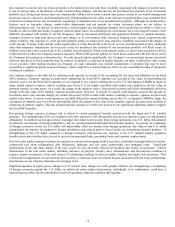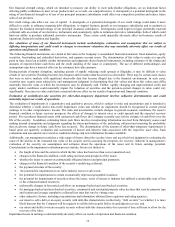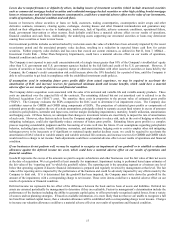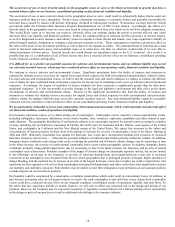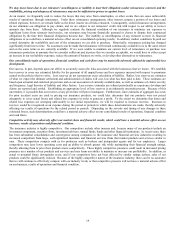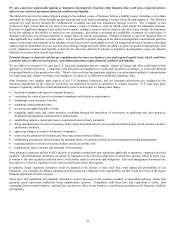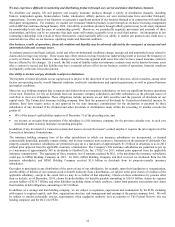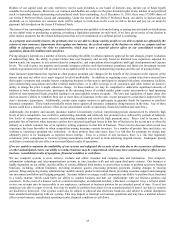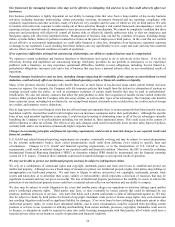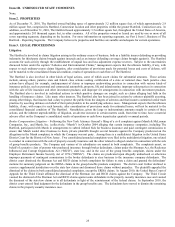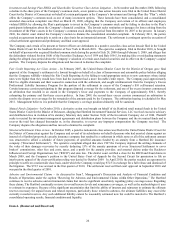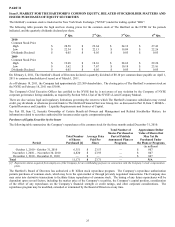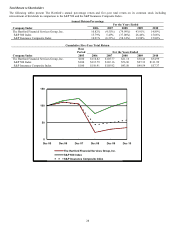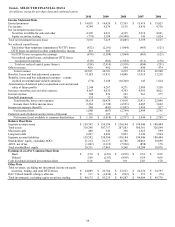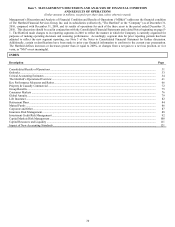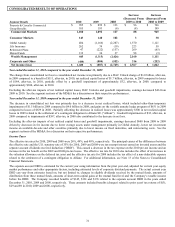The Hartford 2010 Annual Report Download - page 21
Download and view the complete annual report
Please find page 21 of the 2010 The Hartford annual report below. You can navigate through the pages in the report by either clicking on the pages listed below, or by using the keyword search tool below to find specific information within the annual report.
21
We may experience unfavorable judicial or legislative developments involving claim litigation that could have a material adverse
effect on our results of operations, financial condition and liquidity.
The Hartford is involved in claims litigation arising in the ordinary course of business, both as a liability insurer defending or providing
indemnity for third-party claims brought against insureds and as an insurer defending coverage claims brought against it. The Hartford
accounts for such activity through the establishment of unpaid loss and loss adjustment expense reserves. The Company is also
involved in legal actions that do not arise in the ordinary course of business, some of which assert claims for substantial amounts.
Pervasive or significant changes in the judicial environment relating to matters such as trends in the size of jury awards, developments
in the law relating to the liability of insurers or tort defendants, and rulings concerning the availability or amount of certain types of
damages could cause our ultimate liabilities to change from our current expectations. Changes in federal or state tort litigation laws or
other applicable law could have a similar effect. It is not possible to predict changes in the judicial and legislative environment and their
impact on the future development of the adequacy of our loss reserves, particularly reserves for longer-tailed lines of business, including
asbestos and environmental reserves, and how those changes might adversely affect our ability to price our products appropriately. Our
results, financial condition and liquidity could also be adversely affected if judicial or legislative developments cause our ultimate
liabilities to increase from current expectations.
Potential changes in domestic and foreign regulation may increase our business costs and required capital levels, which could have
a material adverse effect on our business, consolidated operating results, financial condition and liquidity.
We are subject to extensive U.S. and non-U.S. laws and regulations that are complex, subject to change and often conflicting in their
approach or intended outcomes. Compliance with these laws and regulations is costly and can affect our strategy, as well as the demand
for and profitability of the products we offer. There is also a risk that any particular regulator’ s or enforcement authority’ s interpretation
of a legal issue may change over time to our detriment, or expose us to different or additional regulatory risks.
State insurance laws regulate most aspects of our U.S. insurance businesses, and our insurance subsidiaries are regulated by the
insurance departments of the states in which they are domiciled, licensed or authorized to conduct business. U.S. state laws grant
insurance regulatory authorities broad administrative powers with respect to, among other things:
• licensing companies and agents to transact business;
• calculating the value of assets to determine compliance with statutory requirements;
• mandating certain insurance benefits;
• regulating certain premium rates;
• reviewing and approving policy forms;
• regulating unfair trade and claims practices, including through the imposition of restrictions on marketing and sales practices,
distribution arrangements and payment of inducements;
• establishing statutory capital and reserve requirements and solvency standards;
• fixing maximum interest rates on insurance policy loans and minimum rates for guaranteed crediting rates on life insurance policies
and annuity contracts;
• approving changes in control of insurance companies;
• restricting the payment of dividends and other transactions between affiliates;
• establishing assessments and surcharges for guaranty funds, second-injury funds and other mandatory pooling arrangements;
• requiring insurers to dividend to policy holders any excess profits; and
• regulating the types, amounts and valuation of investments.
State insurance regulators and the NAIC regularly re-examine existing laws and regulations applicable to insurance companies and their
products. Our international operations are subject to regulation in the relevant jurisdictions in which they operate, which in many ways
is similar to the state regulation outlined above, with similar related restrictions and obligations. Our asset management businesses are
also subject to extensive regulation in the various jurisdictions where they operate.
In addition, future regulatory initiatives could be adopted at the federal or state level that could impact the profitability of our
businesses. For example, the Obama administration has proposed a financial crisis responsibility tax that would be levied on the largest
financial institutions in terms of assets.
These laws and regulations are primarily intended to protect investors in the securities markets or investment advisory clients and
generally grant supervisory authorities broad administrative powers. Compliance with these laws and regulations is costly, time
consuming and personnel intensive, and may have an adverse effect on our business, consolidated operating results, financial condition
and liquidity.


